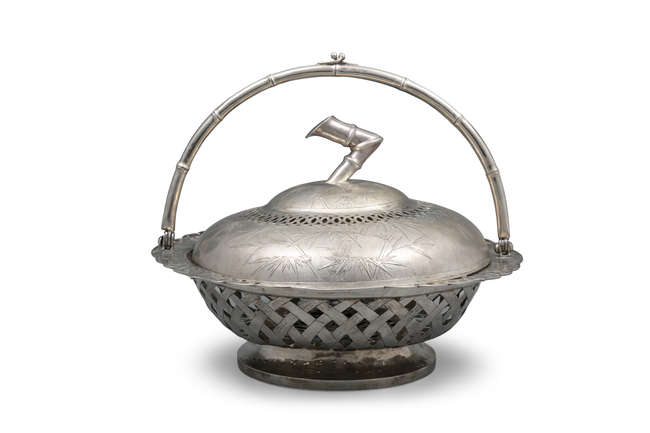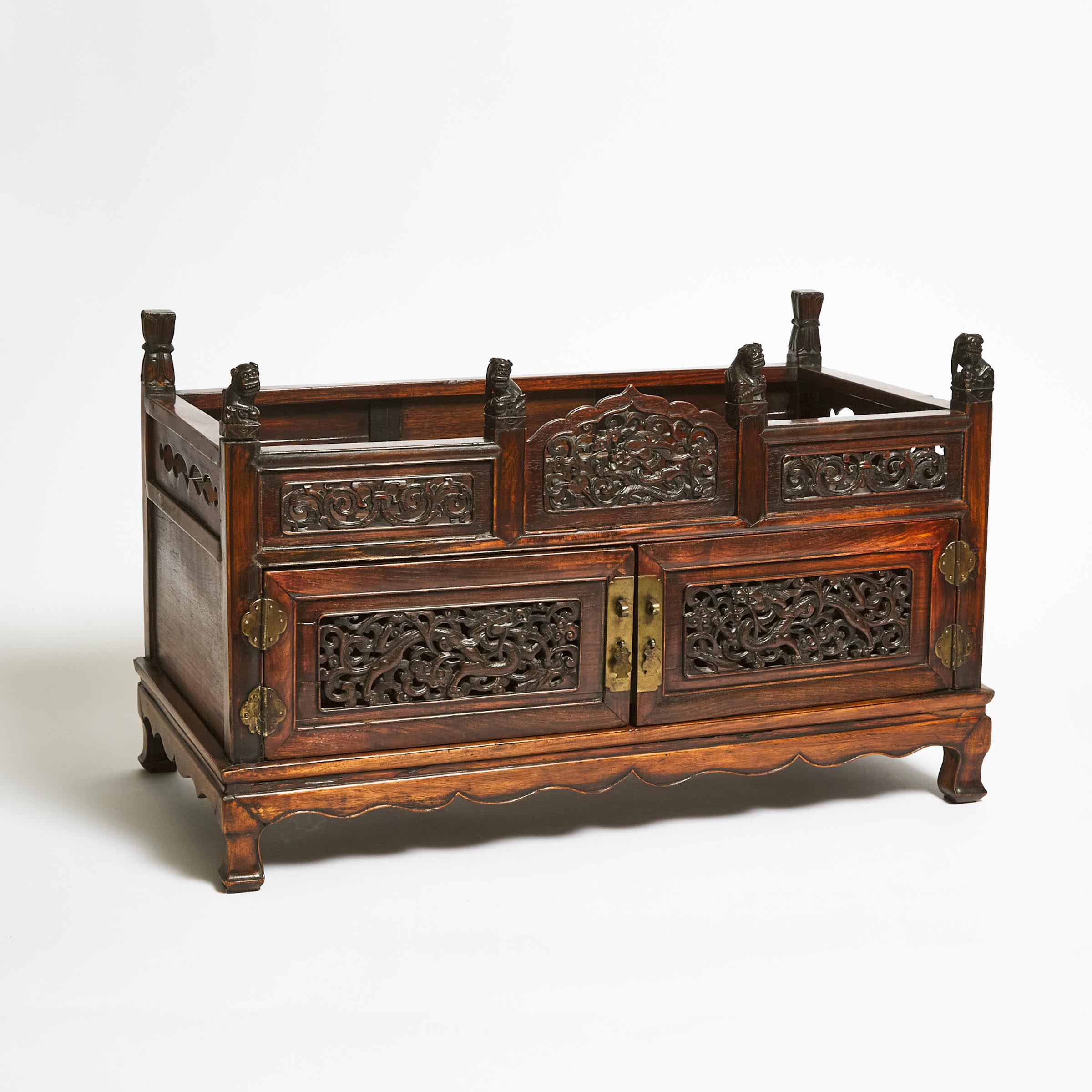Katalognummer: CA0420-194 A LARGE AND RETICULATED SPINACH JADE BRUSHPOT, BITONG, QIANLONG PERIOD China, 1736-1795. Of cylindrical form and intricately carved in deep relief with a continuous scene of three scholars in a monumental landscape, each accompanied by an attendant. The lustrous stone of a rich, slightly mottled spinach-green tone. Provenance: Property from a private English collection. Condition: Superb condition with a naturally grown, unctuous patina and minor wear only. The stone with natural inclusions. The foot rim with a 5 x 45 mm supplement added during production. Weight: 2,084 g Dimensions: Height 16.6 cm and diameter 16.1 cm Brush pots such as the present example depict figures in a dramatic stylized rocky setting, far removed from the sophisticated order of the Imperial court and exemplifying the ideal of the scholar who has withdrawn from the mundane. Like many literati objects, a utilitarian piece becomes, by craftsmanship and decoration together with the use of unusual or rare materials, a vehicle for contemplation and a touchstone for the scholar’s imagination. The depiction is divided into three scenes, each showing the scholar with his attendant. However, unlike most related carvings, this work seems to focus on the relationship between the scholar and his attendant, and not so much on the scholar himself, as we normally see it. The first scene “Preparing Tea” shows the attendant preparing tea for his master, by firing a stove with a fan. Every small detail has been taken care of, including the teapot itself with its microscopic spout, handle, and even the knob on the lid, the latter with a diameter of 0.3 (!) mm. The second scene “The Arduous Journey” shows the scholar with a gnarly staff, carved in reticulated openwork, walking upwards a long path of rock-cut stairs, the attendant following him with a box in his hands. The third scene “Painting at the River” shows the attendant on a river shore with an inkstone and a brush in his hand, while the scholar is observing him from the terrace of a pavilion located on the opposite shore. Both the grinding surface and the inkwell are microscopically carved into the inkstone! The monumental mimesis is completed by craggy layered rockwork, magnificent pines, willows, wutong trees, bamboo and palms as well as several pavilion and pagoda buildings. With a fine associated openwork hardwood base from the late Qing dynasty. (2) Literature comparison: Compare related spinach-green jade brush pots carved with figures in a vast landscape setting, such as a smaller one in the Palace Museum, Beijing, illustrated in Chinese Jades throughout the Ages – Connoisseurship of Chinese Jades, vol. 12, Hong Kong, 1997, pl. 86, and an example of similar dimensions in the National Palace Museum, Taipei, included in the exhibition “The Refined Taste of the Emperor: Special Exhibition of Archaic and Pictorial Jades of the Ch’ing Court”, Taipei, 1997, cat. no. 58. A tripod brush pot in the British Museum, London, is illustrated in Jessica Rawson, Chinese Jade from the Neolithic to the Qing, London, 1995, pl. 29:18, where Rawson notes that the lapidary of the British Museum piece used carving techniques to produce the effects of painting rather than making decorative use of the peculiarities of the stone, as was done in earlier works, a technique that appears to be consistent with the present brush pot. Auction result comparison: Compare with a closely related brush pot with no feet, also showing an attendant preparing tea, at Christies Hong Kong in Important Chinese Jades from the Personal Collection of Alan and Simone Hartman Part II, 27 November 2007, lot 1521, sold for HKD $4,207,500 and another with no feet, also carved with reticulated openwork, at Sotheby’s Hong Kong in Fine Chinese Ceramics and Works of Art, 8 April 2011, lot 3219, sold for HKD $3,620.000. 大型碧玉文人山水筆筒,乾隆時期 中國,1736-1795。圓柱形筆筒,高浮雕精美雕刻三位文人在優美山水場景中作畫,每位學者都伴隨著一位侍童。 玉石潤澤,呈菠菜綠色,略帶斑駁。 來源:可能爲英國私人收藏 品相:品相極好,天然包漿潤澤,僅輕微磨損
Katalognummer: CA0420-194 A LARGE AND RETICULATED SPINACH JADE BRUSHPOT, BITONG, QIANLONG PERIOD China, 1736-1795. Of cylindrical form and intricately carved in deep relief with a continuous scene of three scholars in a monumental landscape, each accompanied by an attendant. The lustrous stone of a rich, slightly mottled spinach-green tone. Provenance: Property from a private English collection. Condition: Superb condition with a naturally grown, unctuous patina and minor wear only. The stone with natural inclusions. The foot rim with a 5 x 45 mm supplement added during production. Weight: 2,084 g Dimensions: Height 16.6 cm and diameter 16.1 cm Brush pots such as the present example depict figures in a dramatic stylized rocky setting, far removed from the sophisticated order of the Imperial court and exemplifying the ideal of the scholar who has withdrawn from the mundane. Like many literati objects, a utilitarian piece becomes, by craftsmanship and decoration together with the use of unusual or rare materials, a vehicle for contemplation and a touchstone for the scholar’s imagination. The depiction is divided into three scenes, each showing the scholar with his attendant. However, unlike most related carvings, this work seems to focus on the relationship between the scholar and his attendant, and not so much on the scholar himself, as we normally see it. The first scene “Preparing Tea” shows the attendant preparing tea for his master, by firing a stove with a fan. Every small detail has been taken care of, including the teapot itself with its microscopic spout, handle, and even the knob on the lid, the latter with a diameter of 0.3 (!) mm. The second scene “The Arduous Journey” shows the scholar with a gnarly staff, carved in reticulated openwork, walking upwards a long path of rock-cut stairs, the attendant following him with a box in his hands. The third scene “Painting at the River” shows the attendant on a river shore with an inkstone and a brush in his hand, while the scholar is observing him from the terrace of a pavilion located on the opposite shore. Both the grinding surface and the inkwell are microscopically carved into the inkstone! The monumental mimesis is completed by craggy layered rockwork, magnificent pines, willows, wutong trees, bamboo and palms as well as several pavilion and pagoda buildings. With a fine associated openwork hardwood base from the late Qing dynasty. (2) Literature comparison: Compare related spinach-green jade brush pots carved with figures in a vast landscape setting, such as a smaller one in the Palace Museum, Beijing, illustrated in Chinese Jades throughout the Ages – Connoisseurship of Chinese Jades, vol. 12, Hong Kong, 1997, pl. 86, and an example of similar dimensions in the National Palace Museum, Taipei, included in the exhibition “The Refined Taste of the Emperor: Special Exhibition of Archaic and Pictorial Jades of the Ch’ing Court”, Taipei, 1997, cat. no. 58. A tripod brush pot in the British Museum, London, is illustrated in Jessica Rawson, Chinese Jade from the Neolithic to the Qing, London, 1995, pl. 29:18, where Rawson notes that the lapidary of the British Museum piece used carving techniques to produce the effects of painting rather than making decorative use of the peculiarities of the stone, as was done in earlier works, a technique that appears to be consistent with the present brush pot. Auction result comparison: Compare with a closely related brush pot with no feet, also showing an attendant preparing tea, at Christies Hong Kong in Important Chinese Jades from the Personal Collection of Alan and Simone Hartman Part II, 27 November 2007, lot 1521, sold for HKD $4,207,500 and another with no feet, also carved with reticulated openwork, at Sotheby’s Hong Kong in Fine Chinese Ceramics and Works of Art, 8 April 2011, lot 3219, sold for HKD $3,620.000. 大型碧玉文人山水筆筒,乾隆時期 中國,1736-1795。圓柱形筆筒,高浮雕精美雕刻三位文人在優美山水場景中作畫,每位學者都伴隨著一位侍童。 玉石潤澤,呈菠菜綠色,略帶斑駁。 來源:可能爲英國私人收藏 品相:品相極好,天然包漿潤澤,僅輕微磨損

.jpg)
.jpg)











Try LotSearch and its premium features for 7 days - without any costs!
Be notified automatically about new items in upcoming auctions.
Create an alert